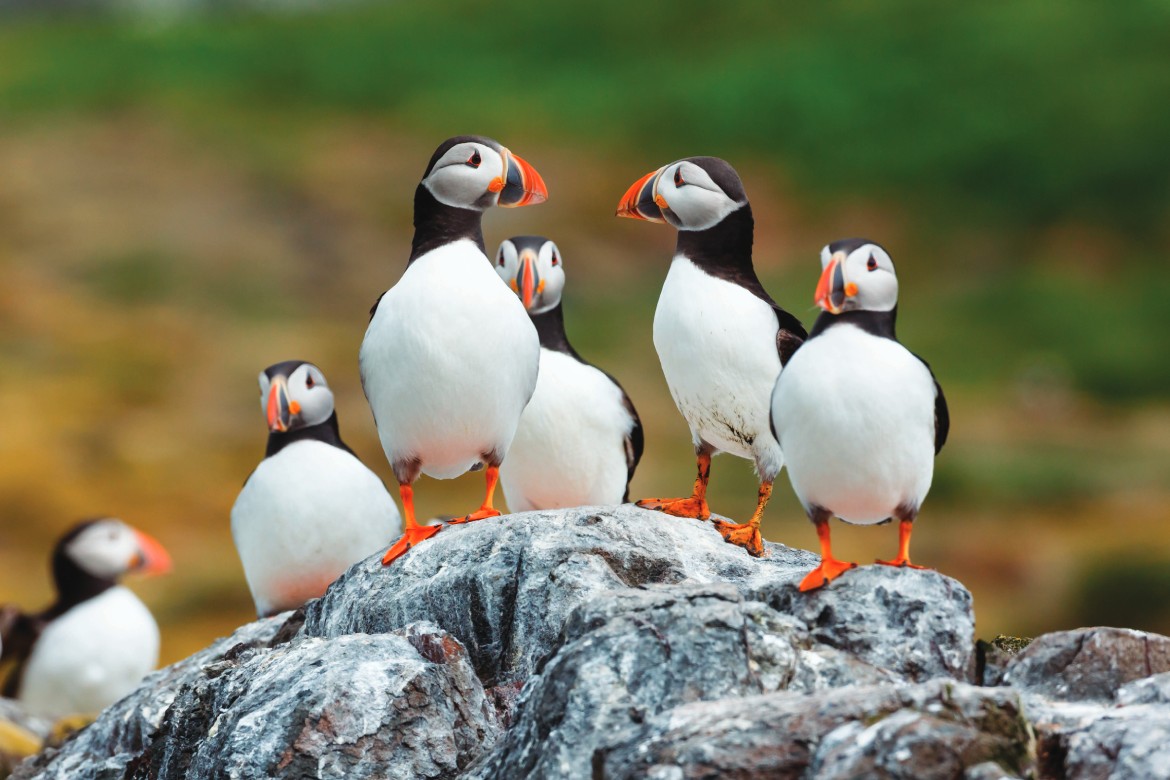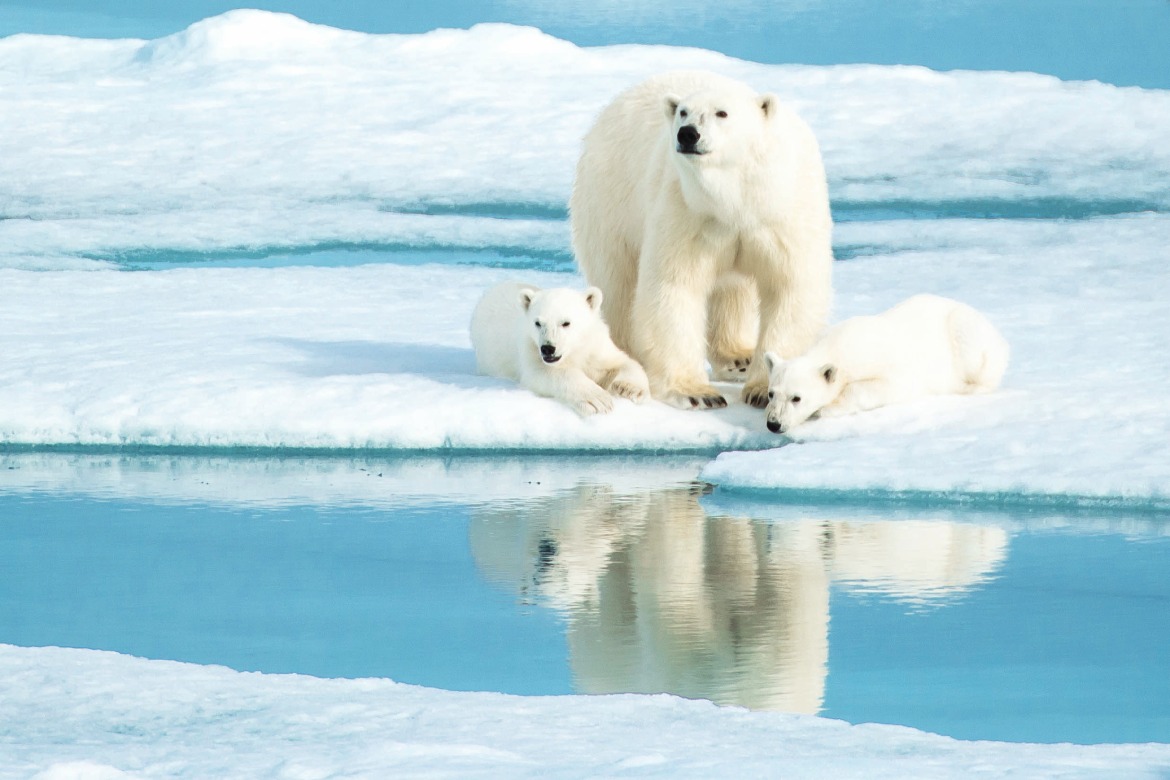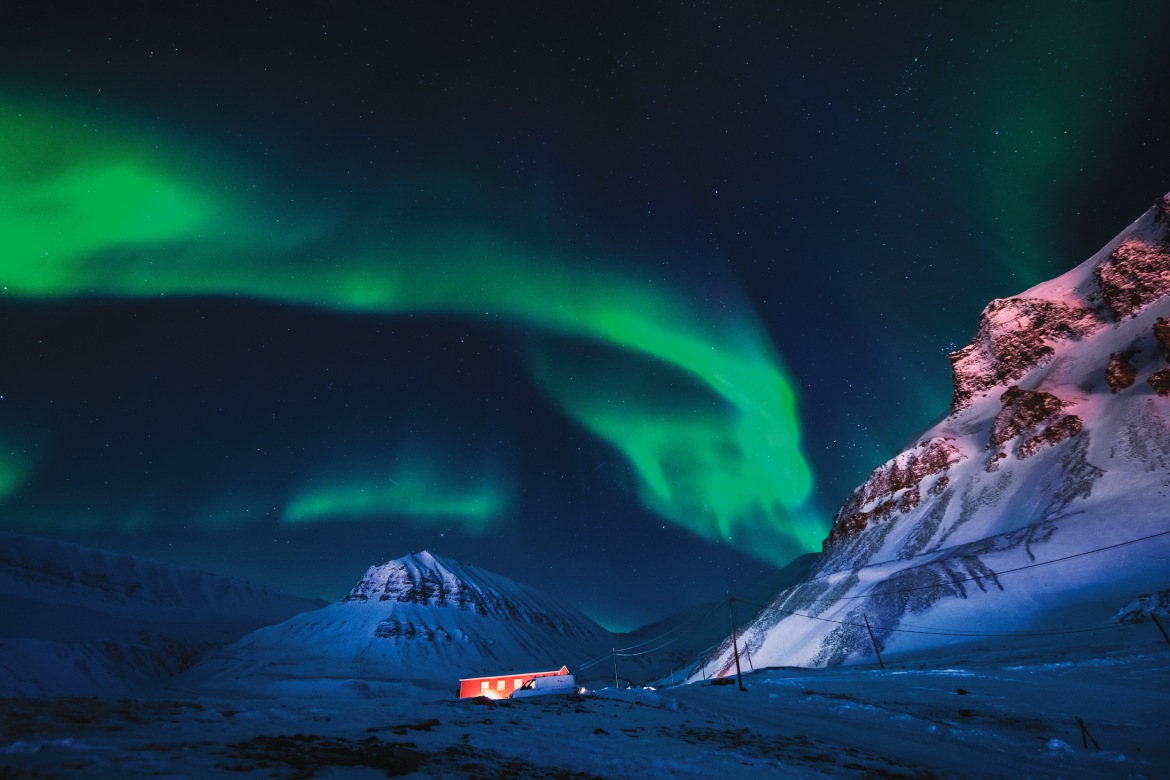“I’m a snowmobile guy, and he’s a dog guy. It takes me thirty minutes to get somewhere, but it might take my friend three hours.” A gruff local explained the winter transportation logistics of Svalbard as I boarded yet another eco-friendly hybrid-electric boat the next morning. Everything, it seemed, revolved around the area’s extreme weather. Our mission aboard the smaller, 14.9-meter Kvitbjørn was to meander up the striking sedimentary mountains of Tempelfjorden, searching for wildlife and seabirds as we made our way towards the brilliant blue of the Tunabreen Glacier.
Powerful fulmars, relatives of the albatross, soared alongside our boat as we passed the tall brown cliffs of Diabas, stained with the guano of thousands of nesting birds. The sunshine sparkled against the frozen shoreline as we passed a series of locals-only public use cabins that Svalbardians can loan out year-round. Surprisingly agile puffins darted to and fro in the wind currents as the Kvitbjørn neared the glacier’s edge, slowing down as we entered a field of icebergs that crackled and popped in the afternoon sun like a humongous bowl of breakfast cereal.

Puffins in Norway (Photo by Pim Leijen)
Tunabreen is known for being one of the most actively calving tidewater glaciers on the archipelago, and it did not disappoint. As our captain cut the engine and allowed us to enjoy the stillness of the crisp northern air, I could hear the occasional rumble of huge hunks of ice falling from the glacier’s steep edge and into the sea, a phenomenon sometimes called “white thunder.”
We passed around cups of hot coffee and cinnamon buns from a local bakery for a floating rendition of Scandinavia’s favorite pastime, fika, a reminder of the importance of stopping and pausing for a few minutes each day to simply listen and enjoy. Given the hybrid boat and our soul-stirring surroundings, I couldn’t think of a better place for a contemplative breather.
I carried this notion with me as I strolled through the streets of Longyearbyen that afternoon, popping into a random café called Huskies that felt like a quintessentially Nordic discovery. The conceit behind the coffee shop was to provide free day care for friendly, retired sled dogs, and in return, beverage-sipping patrons got free cuddles while they lounged and enjoyed the café’s cozy seating nooks.
Though it would have been easy to while away my entire afternoon with the furballs at this homey eatery, it was time, yet again, to jet off on an awe-inducing tour. My quartet of companions met up with a rifle-toting guide to get fitted for helmets and ebikes so that we could set off on a pre-dinner exploration of the scenic byways surrounding the town of Longyearbyen.
“Svalbard is so far north that you have to look south if you want to see the northern lights,” our guide shouted as we pedaled towards the rounded white peaks at the edge of the city. I laughed at the strange realization of just how far I’d traveled from home. “If the weather is good tonight, try to stay up late and gaze up in that direction for the glowing green aurora,” she said as she pointed into the distance.
Clicking my motor to high as we rolled out of town and onto a bumpy dirt road, I zoomed up a hill overlooking the small city of 2,000 and the industrial ruins of an old coal mine that stood in stark contrast to the breathtaking nature all around. Our group meandered along the coastline towards the island’s small airport, passing an electric fence-lined campground (to keep out the, ahem, polar bears) as the sun began to sink, turning the mountains and valleys of Isfjorden to shades of coral and marigold.


Polar Bear Family in Svalbard (Photo by Himanshu Saraf)
Dinner that evening necessitated a special bus ride out of the polar bear safe zone and into the frozen white mountains housing Camp Barentz, a historically accurate replica of the cabin where Willem Barentsz, discoverer of Svalbard, overwintered in 1596. Friendly hosts served up bitter shots of aquavit, along with steaming bowls of reindeer stew. The night’s entertainment was a huge crackling fire that stood at the center of the circular cabin, followed by a slideshow about the area’s most notorious resident, the polar bear. The rifle-toting bathroom chaperones only added to the feeling that I had somehow stumbled up to the very edge of humanity as I knew it, and I found myself gazing out at the twinkling stars as I walked back to our bus, feeling blissfully out of my comfort zone.
The next morning, I ventured out on a solo journey to soak up the island’s rich history at the Svalbard Museum, drifting between impressive taxidermy seals and foxes and full-scale recreations of trapper cabins and vintage coal mining gear. It seemed there was a rugged competence that every person and animal needed to possess if they were to call this exotic icebox home. From whalers to hunters to geological surveyors, a hearty spirit and a deep tolerance for discomfort clearly reigned supreme. That I might be soaking up a speck of their stalwart grace by merely visiting thrilled me.
This desire to stoke my own warm-blooded adventurous spirit could not have been better timed, because the most smile-inducing, adrenaline-pumping event of the entire trip took place that afternoon on a dog sledding adventure with Green Dog Svalbard. Dozens of yowling, manic pups leapt and barked and sniffed at my group from the moment our van pulled up to the kennel on the outskirts of town. Their enthusiasm was contagious, and I couldn’t stop giggling. We each donned a flamboyant yellow jumpsuit and a pair of rubber galoshes to protect against the cold (and the muddy paws), wrestled the hyper canines into their harnesses, and, after a little training on proper sled driving technique, set off into the Arctic wilds.
These puppers could not have been more excited to run. They jolted my sled cart forward, trotting along on the side of the road as though nirvana could be reached by just simply running. I held on tightly as the wagon wheels bumped and jerked along, marveling at the raw power of working dogs. We ventured up and around a backcountry dirt road, pausing to photograph a family of timidly grazing reindeer, before circling back to the kennels for puppy snuggles, hot chocolate, and biscuits.
Our last supper as a group was decidedly American, feasting on burgers and beers at Stationen. But then, as if to up the ante, one of the women I had been traveling with suggested we order a serving of whale carpaccio for the table, since none of us had ever tasted the taboo delicacy before.
Since 1986, there’s been a global moratorium on whaling after overhunting depleted populations dramatically, but a few countries like Japan and Norway have remained eyebrow-raising holdouts to this day. It’s not uncommon to see whale steaks in the supermarket on Svalbard, and they occasionally appear on local restaurant menus. “When would I ever get another chance to see what all the fuss is about?” I thought to myself as a server plopped a plate of raw slivers garnished with sour cream onto our table. I popped a single piece into my mouth, chewed, and swallowed.
Almost instantly, I felt a wave of moral discomfort that prompted a philosophical conversation around our table about the ethics of whaling and how, if the meat doesn’t taste all that different from other, more sustainable products, then clearly it’s the perpetuation of meaningless tradition and ego that’s continuing the bloodshed to this day. I did not opt for a second slice.
After dinner, I stumbled into neighboring Karlsberger Pub, which one of our guides had recommended as “the best dive bar in all of Longyearbyen.” Even at the sunshine-filled hour of 8 P.M., the place was standing room only, and I moseyed over to the main counter to check out their pages-long whiskey list. Overwhelmed and exhausted from days of nonstop adventure, I smiled at the bartender and bellowed, “I dunno…pick one for me!” I ended up with a small glass of something smooth and smoky whose name I couldn’t even pronounce.
It was the perfect ending to a trip filled with swan diving into the unknown while chaperoned by friendly locals who’ve been around the block. Though I’ve spent over a decade exploring the outermost corners of the world, I’d never had an experience quite like my trip to Svalbard, one that somehow seamlessly blended real-deal adventure tourism with comfortable hotel stays and impressive cuisine.
I think that, in our innermost cores, we need wild spaces like this to escape to when our city-sore minds are strung out. We need the vastness of far off landscapes to heal us and help us come back to center. And we need them to be accessible to all types of travelers, comfort-craving as well as gnarled adrenaline junkies, because the thrill of the wild is our birthright.


